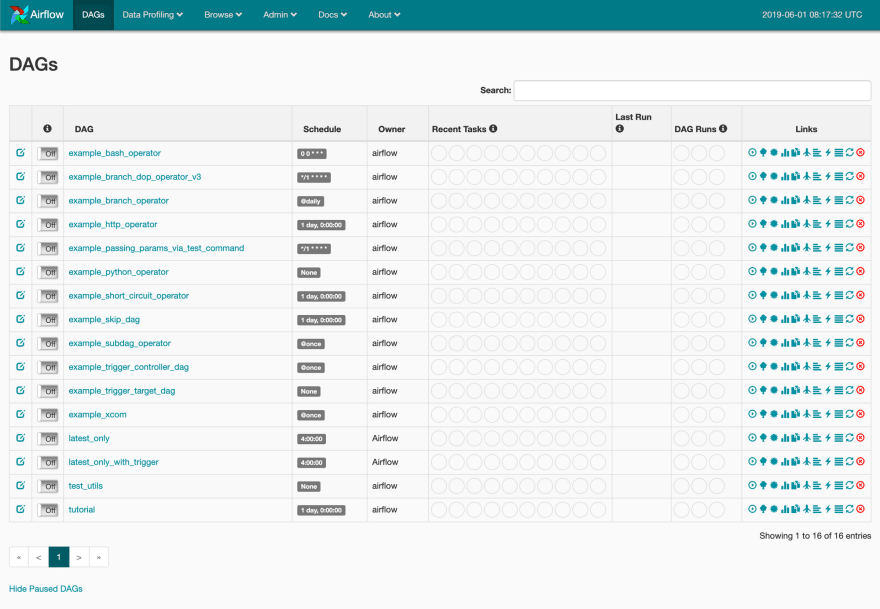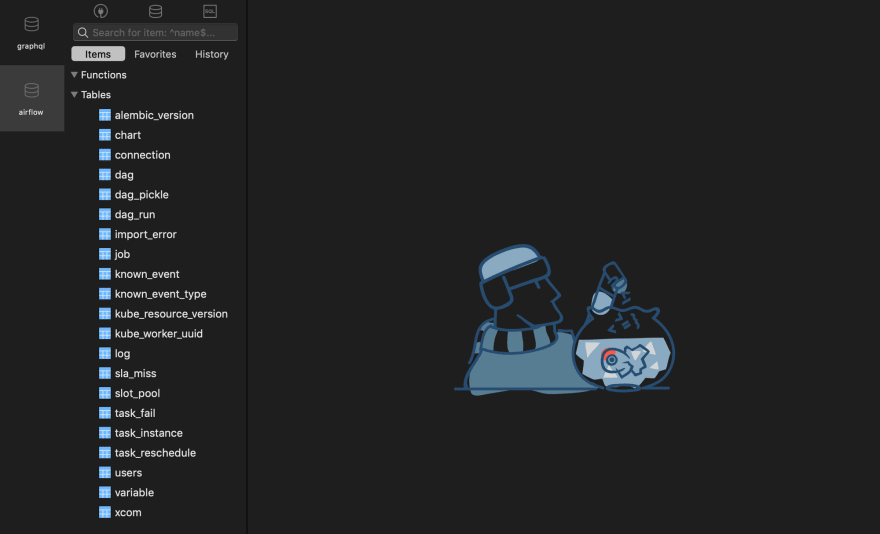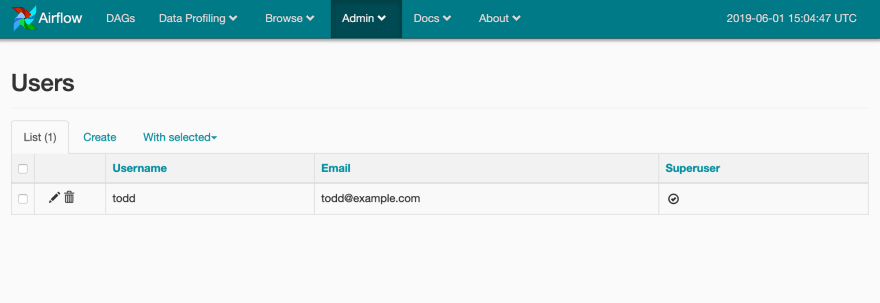It seems like almost every data-heavy Python shop is using Airflow in some way these days. It shouldn't take much time in Airflow's interface to figure out why: Airflow is the missing piece data engineers need to standardize the creation of ETL pipelines. The best part of Airflow, of course, is that it's one of the rare projects donated to the Apache foundation which is written in Python. Hooray!
If you happen to be a data engineer who isn't using Airflow (or equivalent) yet, you're in for a treat. It won't take much time using Airflow before you wonder how you managed to get along without it.
What's the Point of Airflow?
Airflow provides countless benefits to those in the pipeline business. It's not too crazy to group these benefits into two main categories: code quality and visibility.
Airflow provides us with a better way to build data pipelines by serving as a sort of 'framework' for creating pipelines. In the same way a web framework might help developers by abstracting common patterns, Airflow does the same by providing data engineers with tools to trivialize certain repetitive aspects of pipeline creation. Airflow comes with numerous powerful integrations that serve almost any need when it comes to outputting data. By leveraging these tools, engineers begin to see their pipelines abiding by a well-understood format, making code readable to others.
The more obvious benefits of Airflow are centered around its powerful GUI. Wrangling multiple pipelines which are prone to failure might be the least glorious aspect of any data engineer's job. By creating our pipelines within Airflow, we gain immediate visibility across all our pipelines to quickly spot areas of failure. Even more impressive is that the code we write is visually represented in Airflow's GUI. Not only can we check the heartbeat of our pipelines, but we can also view graphical representations of the very code we write.
To get started with Airflow, we should stop throwing the word "pipeline" around. Instead, get used to saying DAG.
What is a DAG?
Airflow refers to what we've been calling "pipelines" as DAGs (directed acyclic graphs). In computer science, a directed acyclic graph simply means a workflow which only flows in a single direction. Each "step" in the workflow (an edge) is reached via the previous step in the workflow until we reach the beginning. The connection of edges is called a vertex.
If this remains unclear, consider how nodes in a tree data structure relate to one another. Every node has a "parent" node, which of course means that a child node cannot be its parents' parent. That's it - there's no need for fancy language here.
Edges in a DAG can have numerous "child" edges. Interestingly, a "child" edge can also have multiple parents (this is where our tree analogy fails us). Here's an example:
In the above example, the DAG begins with edges 1, 2 and 3 kicking things off. At various points in the pipeline, information is consolidated or broken out. Eventually, the DAG ends with edge 8.
We'll dig deeper into DAGs, but first, let's install Airflow.
Installing Airflow
Installing Apache's data services is typically an awful experience. In most cases, things start out by installing some highly specific version of Java after getting harassed to create an Oracle account (please kill me). Once that's done, you usually need to install and configure three or four different Apache services with obnoxious animal-themed names.
Setting up Airflow is refreshingly easy. To get started with a barebones Airflow setup, all we need is to install the apache-airflow Python library:
$ pip3 install apache-airflow
Installing Airflow on its own is fine for testing the waters, but in order to build something somewhat meaningful, we'll need to install one of Airflow's many "extra features". Each Airflow "feature" we install enables a built-in integration between Airflow and a service, most commonly a database. Airflow installs an SQLLite feature by default.
Airflow needs a database to create tables necessary for running Airflow. Chances are we don't be using a local SQLLite database when we use Airflow in production, so I've opted to use a Postgres database:
$ pip3 install apache-airflow[postgres]
$ pip3 install psycopg2-binary
Airflow leverages the familiar SQLAlchemy library to handle database connections. As a result, the act of setting database connection strings should all be familiar.
Airflow has features for much more than just databases. Some features which can be installed with airflow include Redis, Slack, HDFS, RabbitMQ, and a whole lot more. To see everything available, check out the list: https://airflow.apache.org/installation.html
Basic Airflow Configuration
Before we do anything, we need to set an important environment variable called AIRFLOW_HOME. When we initiate Airflow, it's going to look for a folder which matches the name set as the value of this variable. Then, it's going to unpack a bunch of core files needed to run Airflow into said folder:
AIRFLOW_HOME=./airflow
Next we need to unpack the Airflow configuration files into /airflow. This is as simple as running the following command:
$ airflow initdb
A bunch of new files should magically appear in your / airflow directory, like this:
/
├── /airflow
│ ├── airflow.cfg
│ ├── airflow.db
│ ├── /logs
│ │ └── /scheduler
│ │ ├── 2019-06-01
│ │ └── latest -> airflow/logs/scheduler/2019-06-01
│ └── unittests.cfg
└── requirements.txt
Running initdb for the firs time defaults to creating an Airflow instance pointing to a local SQLLite database. Once we run it the first time, we can now change the variables found in our new ./airflow/airflow.cfg file to point to a Postgres database (or database of your choosing).
Database Configuration
To hook Airflow up to a live database, we need to modify a couple of settings in airflow.cfg. Look for the sql_alchemy_conn variable and paste an SQLAlchemy connection string for your database of choice. If you're using Postgres, don't forget to set sql_alchemy_schema as well:
sql_alchemy_conn = postgresql+psycopg2://[username]:[password]@[host]:[post]/[database]
sql_alchemy_schema = public
With those changes made, initialize your database again:
$ airflow initdb
This time around, Airflow should initialize your provided database with a bunch of tables necessary for running the application. I decided to take a peek in my database to see for myself:
Launch Airflow
With everything configured, run the following to kick up Airflow at port 8080:
$ airflow webserver -p 8080
The output should look something like this:
_________________________
____|__ ( ) ___________ / __/________ __
____/| |_ /__ ___/_ /___ /_ __ \_ | /| / /
______ | / _ / _ __/ _ / / /_/ /_ |/ |/ /
_/_/ |_/_/ /_/ /_/ /_/ \ ____/____ /|__/
[2019-06-01 04:38:27,785] { __init__.py:305} INFO - Filling up the DagBag from airflow/dags
Running the Gunicorn Server with:
Workers: 4 sync
Host: 0.0.0.0:8080
Timeout: 120
Logfiles: - -
=================================================================
Now let's see what's going on at localhost:8080 :

Sweet! Airflow is kind enough to create a bunch of example DAGs for us to poke around in. These examples are a pretty good starting point for becoming acquainted.
Before we get too crazy, let's break down the elements of the screen above:
- DAG: Name of a DAG job.
- Schedule: The reoccurring CRON schedule for running the current DAG.
- Owner: Name of the user within your Airflow instance who owns the job.
- Recent Tasks: Visual status (pass/fail/running) of the last 10 times this job ran.
- Last run: Time the DAG was run last.
- DAG Runs: Total number of times a DAG has been executed.
Feel free to click around and break some things while you have the chance.
Anatomy of an Airflow DAG
Any pipeline is essentially just a chain of tasks, and DAGs are no different. Within DAGs, our "tasks" are defined by operators.
Let's take a step back: DAGs are our workflows, and tasks within a DAG are the actions taken by said workflow. An "operator" refers to the type of action a task belongs to, such as a database action or a script action. It isn't crazy to imagine we might have multiple database-related actions in a single DAG: in this case, we'd use the same operator to define multiple tasks (PostgresOperator, assuming we're dealing with Postgres).
Here are some different types of operators:
-
BashOperator: Execute a bash command. -
PythonOperator: Call a Python function. -
EmailOperator: Send an email. -
SimpleHttpOperator: Generate an HTTP request. -
MySqlOperator,SqliteOperator,PostgresOperator: Execute a SQL command. -
DummyOperator: Operator that does nothing (basically for testing purposes).
There's also:
-
DingdingOperator: Sends a message to the "Dingding" Alibaba message service. I didn't know what this was either. - Google Cloud Operators: There are a ton of operators specific to Google cloud services, such as Bigtable operators, Compute Engine operators, Cloud function operators, etc.
- Sensor: Waits for an event to occur before moving forward (can wait for time to elapse, for a script to finish, etc).
Operators can occur at any point in a DAG. We can fire multiple operators throughout the lifetime of a single DAG at any point.
DAGs By Example
Let's explore some of the example DAGs Airflow has provided us. A good place to start is example_python_operator :

Here I'm checking out the Graph View tab of a DAG: this view is the best representation of what's happening from start to finish.
This seems to be a simple DAG: it's just spinning up 5 Python operators which trigger a sleep timer, and nothing else. Run this DAG by clicking the Trigger DAG item in our menu bar, and check the output in whichever console you used to launch Airflow:
[2019-06-01 06:07:00,897] { __init__.py:305} INFO - Filling up the DagBag from /Users/toddbirchard/.local/share/virtualenvs/airflow-a3hcxs5D/lib/python3.7/site-packages/airflow/
example_dags/example_python_operator.py
127.0.0.1 - - [01/Jun/2019:06:07:01 -0400] "POST /admin/airflow/trigger?dag_id=example_python_operator&origin=%2Fadmin%2Fairflow%2Ftree%3Fdag_id%3Dexample_python_operator HTTP/
1.1" 302 307 "http://0.0.0.0:8080/admin/airflow/code?dag_id=example_python_operator" "Mozilla/5.0 (Macintosh; Intel Mac OS X 10_14_4) AppleWebKit/537.36 (KHTML, like Gecko) Chr
ome/74.0.3729.169 Safari/537.36"
127.0.0.1 - - [01/Jun/2019:06:07:01 -0400] "GET /admin/airflow/tree?dag_id=example_python_operator HTTP/1.1" 200 9598 "http://0.0.0.0:8080/admin/airflow/code?dag_id=example_pyt
hon_operator" "Mozilla/5.0 (Macintosh; Intel Mac OS X 10_14_4) AppleWebKit/537.36 (KHTML, like Gecko) Chrome/74.0.3729.169 Safari/537.36"
This doesn't really tell us anything, but then again... isn't that what we'd expect? After all, there aren't any steps which occur after the "sleep" Python operators, so nothingness might be a success here.
To get a better idea, check out the code tab. That's right: we can investigate the source code for any DAG right from our GUI!
from __future__ import print_function
import time
from builtins import range
from pprint import pprint
import airflow
from airflow.models import DAG
from airflow.operators.python_operator import PythonOperator
args = {
'owner': 'airflow',
'start_date': airflow.utils.dates.days_ago(2),
}
dag = DAG(
dag_id='example_python_operator',
default_args=args,
schedule_interval=None,
)
# [START howto_operator_python]
def print_context(ds, **kwargs):
pprint(kwargs)
print(ds)
return 'Whatever you return gets printed in the logs'
run_this = PythonOperator(
task_id='print_the_context',
provide_context=True,
python_callable=print_context,
dag=dag,
)
# [END howto_operator_python]
# [START howto_operator_python_kwargs]
def my_sleeping_function(random_base):
"""This is a function that will run within the DAG execution"""
time.sleep(random_base)
# Generate 5 sleeping tasks, sleeping from 0.0 to 0.4 seconds respectively
for i in range(5):
task = PythonOperator(
task_id='sleep_for_' + str(i),
python_callable=my_sleeping_function,
op_kwargs={'random_base': float(i) / 10},
dag=dag,
)
run_this >> task
# [END howto_operator_python_kwargs]
Every DAG starts out with some basic configuration variables. args contains high-level configuration values:
-
owner: The Airflow user the DAG belongs to (again). -
start_date: The time at which the DAG should execute. -
email: An email address for alert notifications when something goes wrong. -
email_on_failure: When True , a failed execution will email the specified email address with details of the failed job. -
email_on_retry: When True , an email will be sent every time the DAG attempts to retry a failed execution. -
retries: Number of times to retry the DAG in case of a failure. -
retry_delay: Time between retry attempts. -
concurrency: Number of processes to run the DAG. -
depends_on_past: If True , this task will depend on the success of the preceding task before executing.
After setting our DAG's configuration, the DAG is instantiated with dag = DAG(). We pass a few things into DAG() upon creation (like the args we set earlier). This is where we set the DAG's name and schedule time.
In our DAG's graph view, we saw tasks named print_the_context, and a bunch of tasks following a convention like sleep_for_#. In the source code, we can see exactly where these task names are being defined! Check out the first task:
# [START howto_operator_python]
def print_context(ds, **kwargs):
pprint(kwargs)
print(ds)
return 'Whatever you return gets printed in the logs'
run_this = PythonOperator(
task_id='print_the_context',
provide_context=True,
python_callable=print_context,
dag=dag,
)
The first task is being set inside PythonOperator() with an id equal to print_the_context. It's a function that prints some information and returns a string!
Here's the second group of tasks:
def my_sleeping_function(random_base):
"""This is a function that will run within the DAG execution"""
time.sleep(random_base)
# Generate 5 sleeping tasks, sleeping from 0.0 to 0.4 seconds respectively
for i in range(5):
task = PythonOperator(
task_id='sleep_for_' + str(i),
python_callable=my_sleeping_function,
op_kwargs={'random_base': float(i) / 10},
dag=dag,
)
This is super cool: this time, the Python operator is in a for loop. This is an excellent demonstration of how we can create DAGs dynamically!
Think you have what it takes to create your own DAG? I think you do too. Let's set the stage.
Getting Ready to Create Our Own DAG
There are a couple of housekeeping items we should knock out before moving forward. This won't take long.
Create an Airflow User
As we've already seen, DAGs need to have an "owner". The default DAGs we've seen so far set their user as airflow. We can't do this with the new DAGs we create -we need to set a legitimate user. In your Airflow UI, navigate to Admin > Users.
Then, create a user that will "own" our new DAG.
Create a New Connection
To simulate a real-world scenario, we should have our DAG insert information into a database. Destinations for DAG output need to be created and managed in the Airflow UI, under Admin > Connections.
I've started setting up a Postgres connection below:

Creating our First DAG
Shut down your web server and create a folder within /airflow called /dags. This will be where we store the source code for DAGs we create moving forward (the location of your DAGs can be changed in airflow.cfg, but /dags is the default). Create a Python file in /dags named something along the lines of my_first_dag.py (the name of the file doesn't matter tbh).
I'm going to create a DAG made up of three tasks. These tasks will use the Bash , Python , and Postgres operators:
from airflow import DAG
from airflow.operators.bash_operator import BashOperator
from airflow.operators.python_operator import PythonOperator
from airflow.operators.postgres_operator import PostgresOperator
from datetime import datetime, timedelta
default_args = {
'owner': 'todd',
'depends_on_past': False,
'start_date': datetime(2015, 6, 1),
'email': ['todd@example.com'],
'email_on_failure': False,
'email_on_retry': False,
'retries': 1,
'retry_delay': timedelta(minutes=5)
}
dag = DAG(dag_id='my_custom_dag',
default_args=default_args,
schedule_interval=timedelta(days=1))
# Task 1
t1 = BashOperator(
task_id='print_date',
bash_command='date',
dag=dag)
# Task 2
def my_python_function():
now = datetime.now()
response = 'This function ran at ' + str(now)
return response
t2 = PythonOperator(
task_id='my_python_task',
python_callable=my_python_function,
params={'my_param': 'Parameter I passed in'},
dag=dag)
# Task 3
t3 = PostgresOperator(task_id='my_postgres_task',
sql="INSERT INTO test VALUES (3, 69, 'this is a test!');",
postgres_conn_id='my_postgres_instance',
autocommit=True,
database="airflow2",
dag=dag)
# Pipeline Structure
t2.set_upstream(t1)
t3.set_upstream(t2)
I've purposely set a bunch more arguments in default_args to demonstrate what this would look like. Note the value of the owner argument.
Check out the tasks we created:
- Task 1 is a simple bash function to print the date.
- Task 2 returns the current time via a Python function.
-
Task 3 inserts a bunch of values into a Postgres Database (inserts 3 values:
3, 69, 'this is a test!').
The last part of our script is muy importante: this is where we set our pipeline structure. set_upstream() is one way we set the order of operations to occur: by calling set_upstream() on each task, it is inferred that t1 will be the first task. Forgetting to set your pipeline structure will result in tasks that don't run! There are a couple of other ways to set this:
-
set_downstream()achieves the opposite ofset_upstream(). -
t1 >> t2 >> t3is a cleaner way of handling a straightforward DAG like this one.
We should be able to see the structure of this DAG in the UI's graph view now:

Testing Our DAG
If you're like me, your DAG won't run the first time. This can be very frustrating. Luckily, there's an easy way to test tasks in our new DAG via the Airflow CLI. Simply enter the below:
airflow test [your_dag_id] [your_task_name_to_test] [today's_date]
This is what I entered to test the Postgres task:
airflow test my_custom_dag my_python_task 06/01/2019
After some adjustments, I was able to receive a success:
[2019-06-01 11:36:49,702] { __init__.py:1354} INFO - Starting attempt 1 of 2
[2019-06-01 11:36:49,702] { __init__.py:1355} INFO -
--------------------------------------------------------------------
[2019-06-01 11:36:49,702] { __init__.py:1374} INFO - Executing <Task(PythonOperator): my_python_task> on 2019-06-01T00:00:00+00:00
[2019-06-01 11:36:50,059] {python_operator.py:104} INFO - Exporting the following env vars:
AIRFLOW_CTX_DAG_ID=my_custom_dag
AIRFLOW_CTX_TASK_ID=my_python_task
AIRFLOW_CTX_EXECUTION_DATE=2019-06-01T00:00:00+00:00
[2019-06-01 11:36:50,060] {python_operator.py:113} INFO - Done. Returned value was: This function ran at 2019-06-01 11:36:50.060110
Surely enough, the record was created in my database!











Top comments (0)